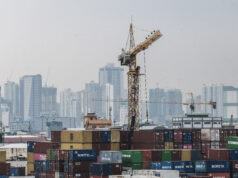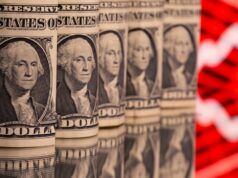August inflation fastest in nearly a decade

HEADLINE INFLATION in August caught state economic managers and financial markets by surprise, shooting up to its fastest clip in almost a decade, according to official data the Philippine Statistics Authority (PSA) released on Wednesday.
PSA data showed that the prices of widely used goods increased by 6.4%, higher than July’s 5.7% and August 2017’s 2.6%. The latest figure was the fastest since March 2009 when it registered 6.6%.
August’s pace also pierced the 5.5%-6.2% range estimated by the Bangko Sentral ng Pilipinas’ (BSP) Department of Economic Research as well as the 5.9% estimate of the Department of Finance and the median in BusinessWorld’s poll of economists.
Year-to-date, headline inflation averaged 4.8%, higher than the BSP’s target range of 2-4% for the year and right below its upward-revised 4.9% forecast for 2018.
Core inflation, which excludes food and energy items, clocked in at 4.8%, higher than last month’s 4.5% and August 2017’s 2.2%.
Financial markets reeled from the data, with the Philippine Stock Exchange index dropping 1.64% to 7,752.27 and the peso weakening to a fresh 12-year-low P53.55 to the greenback.

NEED FOR ACTION
“An unfortunate confluence of cost-push factors continues to drive consumer price inflation in August beyond the acceptable target range. Much of it has to do with food supply shocks, [r]ice in particular,” BSP Governor Nestor A. Espenilla, Jr. told reporters via Viber yesterday, adding that these factors “warrant more decisive non-monetary measures.”
“Elevated oil prices also continue to impact transport and power prices. At the same time, the peso (along with other currencies) is being adversely affected by emerging market uncertainties and a strong US dollar. These are adding to the cost-push pressures.”
The central bank governor further cautioned that the strong domestic demand is “making it too convenient” for producers and traders to pass on higher costs to consumers.
The food-alone index for August was 8.2%, higher than last month’s 6.8% and last year’s 3.1%. The PSA noted that, except for corn, most food subindices posted higher annual mark-ups in August.
“The government, particularly the Department of Agriculture, must act quickly and fervently with a sound judgment to ease the increasing prices of agricultural commodities which are the main drivers of inflation,” Socioeconomic Planning Secretary Ernesto M. Pernia was quoted in the statement of the National Economic and Development Authority (NEDA) as saying.
“While the government’s economic team expected inflation to peak in the third quarter before tapering off towards the latter part of the year, inflation in August is largely beyond the median market forecast. That is why we remain steadfast in putting forward measures that will address prices, especially for food.”
NEDA issued a separate joint statement of the Cabinet’s economic development cluster which met Wednesday “to address food inflation.” The meeting — among representatives of BSP, NEDA, the Department of Finance, the Department of Budget and Management, the Department of Trade and Industry (DTI), the Department of Agriculture (DA), the Department of Justice, the Bureau of the Treasury and the National Food Authority (NFA) Council — drew up a list of “immediate reforms for reducing food prices”, including “immediately” releasing 4.6 million sacks of rice from NFA warehouses “to the market across the country”; authorization by the NFA Council for importation of 5 million sacks of rice that will arrive in the next one-and-a-half months and another 5 million sacks to arrive “early next year”; facilitating the distribution of imported fish to wet markets; formation of teams consisting of law enforcers and farmers groups to monitor transport of rice from ports to NFA warehouses to retail outlets; DA to provide cold storage for chicken and, with DTI, to put up outlets where producers can sell directly to the public; while the Bureau of Customs “will prioritize the release of essential food items in the ports”.
In a separate statement, Albay Rep. Clemente “Joey” S. Salceda, senior vice-chairman of the House of Representatives committee on ways and means, said that the August inflation was “self-inflicted.”
“Ultimately, the 6.4% [August inflation figure] was really due to the fact that we did little or nothing. We can no longer blame [market profiteers] and rice hoarders. The only notable measure we implemented in response was the 50 basis point (bp) increase in policy rates of the BSP, but it would take a lag of 6-18 months for monetary action to gain traction in containing aggregate demand,” Mr. Salceda said.
“[W]hat is more worrisome is that it would reverse gains in poverty reduction and hunger mitigation since the main culprit is food inflation… Thus, the inflation of the poor (lowest 30%) is estimated at 7.4%.”
The Development Budget Coordination Committee (DBCC) — which is composed of the Department of Budget and Management, Department of Finance, and NEDA — will convene later this year to adjust upward its inflation assumption for the year, even as it will keep the estimate for 2019, and possibly review the economic growth target as well.
“The DBCC meets quarterly; so in the light of this we will call for a meeting,” Budget Secretary Benjamin E. Diokno said in a media briefing yesterday when asked whether the government will review its economic assumptions.
Asked whether the DBCC’s new inflation forecast could reach 5%, Mr. Diokno said: “There’s always a possibility.”
The body currently forecasts a 4-4.5% inflation rate for 2018 and 2-4% in 2019.
He said the body will also consider adjusting the gross domestic product growth for this year, following the slower-than-expected six percent economic growth figure in the second quarter that fueled a 6.3% expansion last semester against the year-ago 6.6%.
OUTLOOK
“The BSP will be looking more closely at the latest data to reassess the medium-term inflation path. We also need to consider external developments and US [Federal Reserve] actions to the extent these exert undue pressure on the peso,” BSP’s Mr. Espenilla said.
“Under the circumstances, we will weigh the need for further monetary policy action. Appropriate recommendations will be presented to the MB (Monetary Board) on Sept. 27 at its next policy meeting. It is most critical at this point to restore inflation back to the target range soonest and securely anchor inflationary expectations.”
Economists interviewed were largely in agreement that the latest inflation data made the case for another rate hike.
“The chances of another aggressive monetary policy action has zoomed as inflation surged. Another 50bp policy rate hike at the Sept. 27 meeting is a real possibility,” said ING Bank N.V. Manila senior economist Jose Mario I. Cuyegkeng.
ANZ Research likewise expects a stronger policy response, saying in a research note: “With inflation surpassing six percent for the first time since March 2009… bringing it back below target will require more policy response given cost-push pressures in the economy.”
“We now expect BSP to increase its overnight reverse repurchase rate by 50 bp at the upcoming Sept. 27 meeting to 4.50%, compared to our earlier expectation for a 25 bp hike.”
For Nomura economist Euben Paracuelles: “[T]his higher-than-expected pick-up in headline inflation could further stoke inflation expectations, raising the risk of BSP hiking again by a relatively aggressive 50bp this month, with possibly more to come.” — VMPG and Elijah Joseph C. Tubayan with C. A. Tadalan



